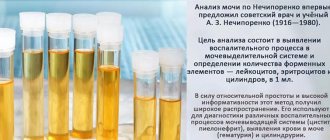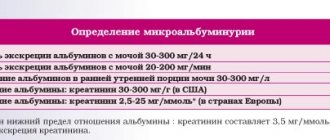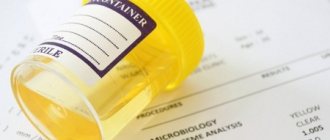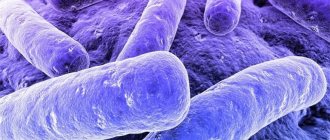Author
Lukyanchikov Denis Vladimirovich
Leading doctor
Urologist
until September 30
We're giving away RUR 1,000 for all services per visit in September More details All promotions
Urinalysis according to Zimnitsky is a laboratory diagnostic method that allows you to study the functional state of the kidneys. Using the Zimnitsky urine test, the ability of the kidneys to concentrate and excrete urine is assessed.
Urine is produced in the kidneys by filtering blood. During the day, the kidneys pass 1800 liters of blood, while normally 1.5-2 liters of urine should be released. The body's waste products are eliminated through urine. Also, with the help of urine secretion, water balance is regulated. If the body receives little fluid, little urine is produced, but it becomes more concentrated. If there is a lot of fluid received (for example, when drinking a lot), the concentration of urine drops. When kidney function is impaired, this mechanism stops working, as a result, the water balance is disrupted, the composition of the blood changes, and this affects the general condition of the body.
Urinalysis according to Zimnitsky allows you to determine how much urine is excreted per day and what the concentration of urine is.
Collection of urine for analysis according to Zimnitsky
Urine collection for analysis according to Zimnitsky is carried out within 24 hours. To do this you will need 8 sterile containers (jars).
Urine collection begins in the morning. The first portion of urine after waking up is not collected, but goes down the toilet. Next, the urine is collected in jars, for which a separate jar is used every three hours:
- from 9-00 to 12-00 am;
- from 12-00 to 15-00;
- from 15-00 to 18-00;
- from 18-00 to 21-00;
- from 21-00 to 24-00;
- from 0-00 to 3-00;
- from 3-00 to 6-00 am;
- from 6-00 to 9-00 am.
Collected urine samples should be stored in the refrigerator. After collecting the last portion of urine, all material should be delivered to the laboratory.
Preparing the patient for a general urinalysis and urine analysis according to Zimnichsky
How to properly prepare and take a urine test
Preparing for the test
The composition of urine is influenced by many factors - our food and drink, stress, physical activity, taking medications and dietary supplements. To ensure that the examination results are not distorted by random factors, you should prepare for a general urine test.
- 1. The day before collecting biomaterial, you should avoid foods that can change the color of urine (for example, brightly colored fruits, vegetables and dishes made from them, smoked meats, sweets and marinades).
- 2. You should not drink alcohol, take vitamins, dietary supplements, or diuretics (including coffee).
- 3. If you are taking any medications, tell the doctor who referred you for the test.
- 4. Try to avoid serious physical activity, baths and saunas.
- 5. Menstruation, an infectious disease with an increase in temperature, or a significant increase in blood pressure are a good reason to reschedule the tests; the results will still be distorted.
- 6. It is not recommended to take a urine test within 5–7 days after cystoscopy.
General urine analysis
Samples must not be contaminated with foreign matter. Therefore, you must follow all the rules for collecting material.
- — For a general urine test, morning urine is used, which is collected in the bladder during the night.
- — Before collecting the material, you should take a shower—failure to comply with this rule may result in the detection of an increased number of red and white blood cells in the urine.
- — Dishes for collecting samples must be sterile, without traces of cleaning agents and disinfectants. Nowadays, disposable containers are mainly used for these purposes.
- — To prevent bacteria from the external genitalia from getting into the sample, you need to release a small amount of urine into the toilet, and then, without stopping urination, place a container and collect 100–150 ml. The container should not touch the skin.
- — Urine collected for general analysis can be stored for no more than 1.5–2 hours, and always in a cool place, at a temperature of 5–18? C. Urine that has been stored at room temperature is not suitable for analysis.
- — Sterile urine bags are used to collect urine from newborns. Otherwise, the rules for children are the same as for adults. Urine is collected in the morning; before collecting the material, the baby must be thoroughly washed and dried with a clean, dry towel.
- Rules for the collection and storage of urine according to Zimnitsky
- The patient must collect biological fluid throughout the day. This will have to be done even at night. To collect urine you will need 8 clean and dry containers. On them the patient indicates his last name and initials, the serial number of the portion and the time interval.
- You need to collect urine for analysis according to Zimnitsky as follows. During the first bowel movement after waking up between 06:00 and 09:00, no biological fluid is taken.
- Then, from 09:00, 8 portions of urine are collected:
- from 09:00 to 12:00 – portion No. 1;
- from 12:00 to 15:00 – portion No. 2;
- from 15:00 to 18:00 – portion No. 3;
- from 18:00 to 21:00 – portion No. 4;
- from 21:00 to 24:00 – portion No. 5;
- from 24:00 to 03:00 – portion No. 6;
- from 03:00 to 06:00 – portion No. 7;
- from 06:00 to 09:00 – portion No. 8.
- During these periods of time, a person may experience several urges to urinate. All liquid is collected . This needs to be taken into account. You cannot pour anything into the toilet. If a particular jar is overfilled, then an additional container is taken to collect it. It indicates the corresponding time interval. It can also happen when a person does not want to go to the toilet at a certain time. In this case, the jar is left empty and sent as is.
- The volume of urine in each sample is measured and recorded. After the last portion is ready, all jars, including empty ones, are sent to the laboratory.
- Another important point is that the patient needs to measure the amount of fluid consumed. Not only the water or juice you drink is taken into account. The liquid contained in the food is also taken into account. The doctor needs this information to correctly interpret the results.
- Urine for analysis according to Zimnitsky should be stored in closed containers in a cool place. You can use a refrigerator. The storage temperature should not fall below zero.
Relative density of urine
Hyposthenuria
– low urine density (in none of the portions does the urine density exceed 1.012–1.013 g/ml) indicates a violation of the concentrating ability of the kidneys, the cause may be:
- chronic renal failure;
- heart failure;
- diabetes insipidus.
Hypoisosthenuria
– the density of urine in each portion of Zimnitsky’s test does not exceed 1.009 g/ml and practically does not change throughout the day. The cause may be severe kidney failure.
Hyperisosthenuria
– constantly high specific gravity of urine, the cause may be:
- diabetes;
- acute or chronic glomerulonephritis;
- toxicosis of pregnant women;
- nephrotic syndrome.
Why do the Zimnitsky test?
Urinalysis according to Zimnitsky helps the doctor make the correct diagnosis and select effective treatment. The study allows you to obtain accurate information not only about the volume of urine produced, but also about the salt content in it.
Indicators that are checked during analysis:
- Daily diuresis is the amount of urine excreted in 24 hours.
- The ratio of the amount of liquid drunk to the volume of urine excreted.
- Daytime diuresis.
- The amount of fluid excreted per night (nocturnal diuresis).
- Urine density.
Typically, the Zimnitsky test is prescribed to patients suffering from heart failure, diabetes mellitus, chronic pyelonephritis, hypertension, and also to pregnant women if systematic swelling of the limbs is diagnosed.
Methodology for collecting clinical diagnostic studies
GBUZ KO "Belovskaya City Children's Hospital" instructions
General urine analysis: collection method
Preparing the patient for a general urine test
- immediately before collecting urine, carry out a hygienic procedure - mandatory toileting of the external genitalia;
- no restrictions in diet or nutrition are required (but it is recommended not to eat vegetables and fruits that stain urine the day before, and not to take diuretics);
- For the study, it is necessary to collect all morning urine in a dry, clean container. Currently, special disposable plastic containers with a lid are used.
Urine collection
In infants, urine collection is difficult. Urine can be collected using disposable plastic bags with adhesive edges.
To reduce the unpleasantness of this procedure for the child, choose a time close to feeding, since experience has shown that an infant urinates before and immediately after feeding.
An older infant can be held over a clean potty if he is accustomed to urinating “on command.” For older children, urine is taken directly into a jar.
For research, all morning urine, as the most concentrated, is collected in clean, dry dishes, well washed from cleaning agents and disinfectants. The container with urine is tightly closed with a lid.
Urine samples (100-150 ml) should be sent to the laboratory immediately (no later than 1 hour after it is collected).
Urinalysis according to Nechiporenko: collection method
Patient preparation
- In the evening and morning, before collecting urine, carry out a hygienic procedure - a mandatory thorough toilet of the external genitalia: the perineal area (in girls) or the area of the external opening of the urethra (in boys).
- The average portion of morning urine is collected after sleep.
Nechiporenko urine collection procedure and transportation
- Start urinating into the toilet.
- Continue urinating into the prepared container (5-10 ml is needed for the study).
- Finish urinating into the toilet.
- Close the container with urine with a lid.
- Wash the hands.
Urine samples should be sent to the clinical laboratory immediately.
Stool examination (coprogram)
Patient preparation
- the patient is on a normal diet;
- Feces are collected from clean diapers; pre-washed and treated bedpan,
pot.
- Collect into a clean glass jar with a wooden spatula.
small pieces of material (5-10 g) from three different places.
- Feces should not contain foreign impurities (urine, water, disinfectants). It is forbidden
use feces after a cleansing enema, the use of rectal suppositories, ingestion of laxatives, iron, bismuth, belladonna, during diarrhea, in the first 2-3 days after an X-ray examination of the gastrointestinal tract with the administration of barium sulfate.
- The container is tightly closed and immediately sent to the clinical laboratory.
Examination of stool for the presence of parasites (worm eggs and protozoan cysts)
- In the morning the child is placed on a potty pre-treated with boiling water or laid down
onto a clean diaper.
- After defecation, the jar or bottle is collected with a spatula or wooden spatula.
three different places a small amount of material. Do not use stool mixed with urine, water, disinfectants, after an enema, use of rectal suppositories, ingestion of substances that color feces, intake of castor and vaseline oil, iron preparations, bismuth, barium.
- The feces are delivered to the laboratory within 30 minutes.
To obtain a more accurate result, when taking stool for helminth eggs, fresh stool should be sent to the laboratory. Helminth eggs may not appear in the stool every day, so the analysis should be repeated several times.
When taking stool for protozoan cysts (Giardia), in order to obtain a more accurate result, it is advisable to deliver the material to the clinical laboratory immediately after defecation (warm).
Scraping for enterobiasis (for pinworm eggs)
- The examination is carried out in the morning before defecation and urination, and before children get out of bed.
The child is not washed, the underwear is not changed.
- With your left hand, spread the child’s buttocks, and with your right hand, scrape the perianal folds with a wooden stick with a cotton swab at the end (the swab should be moistened with boiled water and wrung out).
Taking material for research can be done using adhesive transparent tape, which is applied to the perianal folds with the sticky side, and then covered with a glass slide. You can also use a wooden spatula moistened with a 50% glycerin solution or a 1% soda solution to lightly scrape the surface of the perianal folds along the entire circumference of the anus.
- The spatula is dipped into a bottle with 2-3 drops of a 50% glycerin solution, the bottle is placed in a cell of the box and delivered to the laboratory. If there is no spatula, use matches with tightly wound cotton wool (small).
For greater reliability of the results, it is recommended to repeat the study 2-3 times with an interval of 5-7 days.
- A blood test for general analysis is carried out in the morning, on an empty stomach.
- It is not recommended to take blood after physical and mental stress,
the use of medications, especially when administered intramuscularly or intravenously, ultrasound, exposure to x-rays and after physiotherapeutic procedures.
- Repeated studies must be repeated at the same hours, since the morphological
Blood composition is subject to fluctuations throughout the day.
- If these rules are not followed, the results of the study will not be comparable with each other and
may lead to misdiagnosis.
Urine analysis according to Zimnitsky: collection method
Patient preparation
- The patient remains on a normal diet, but the amount of alcohol consumed is taken into account.
liquids (per day);
- before the study, the patient must stop diuretics;
- in the morning, toilet the external genitalia (hygienic toilet before taking
each portion of urine is optional).
- The night before, prepare 8 clean, dry containers and 8 labels
- Attach a label to each jar indicating the serving number and time (6-9 hours, 9-12 hours, 12
15 hours and so on). The date on portions No. 7 (24-3 hours) and No. 8 (3-6 hours) changes.
Procedure for collecting and transporting urine
During the test, urine is collected over a 24-hour period from 6 a.m. the previous day to 6 a.m. the next day. After emptying the bladder at 6 a.m., urine is collected every 3 hours in separate dry, clean jars throughout the day, 8 servings in total.
At 6 a.m. the child should urinate into the toilet, and from 6 to 9 a.m. he should urinate into the first container, from 9-12 a.m. into the second container, and so on. At 6 o'clock in the morning the next day, the last portion is collected.
If the patient does not have enough volume of one vessel, an additional jar is needed, on which a label is affixed - “Additional portion” to portion no. If there is no urination at the specified time, the corresponding jar remains empty, but is delivered to the laboratory with all the others.
If your child has a bowel movement somewhere between the hours indicated on the jars (for example, 10 o'clock), he should first urinate in a jar marked 9-12 o'clock.
At night, a sick child must be woken up.
All containers with urine (in total are sent to the laboratory in the morning.
are sent to the laboratory in the morning.
Interpretation of the result
At the medical office, you can get personal advice from a doctor from the “Doctor Q” service on interpreting the results of the study during your appointment or by phone.
It must be remembered that interpretation of the results of a urine test according to Zimnitsky should only be carried out by a doctor, since the results of laboratory tests are not the only criterion for making a diagnosis and prescribing appropriate treatment. They should be considered in conjunction with medical history and the results of other possible examinations, including instrumental diagnostic methods.
An adult normally excretes approximately 67–75% of the liquid he drinks during the day. Daytime diuresis should exceed nighttime and amount to 2/3–3/4 of the total amount of daily urine. The relative density during the day ranges from 1.005 to 1.025 g/ml.
If night diuresis predominates over daytime diuresis, then this indicates a decrease in the concentrating ability of the kidneys. Nocturnal predominance of diuresis is often found in diabetes insipidus and heart failure.
An excess of urine density above 1.025 g/ml is observed in cases of dehydration, pyelonephritis, and uric acid diathesis in children.
A decrease in urine density below 1.005 g/ml indicates a decrease in the concentration function of the kidneys and occurs in renal failure, chronic glomerulonephritis and pyelonephritis, diabetes insipidus and diabetes mellitus, hyperaldosteronism, while taking diuretics, severe potassium deficiency, excess calcium,
To confirm the resulting pathological abnormalities, the doctor may prescribe stress tests to the patient to dilute and concentrate urine.
Detailed description of the study
24-hour urine test to analyze the concentrating ability of the kidneys.
The main function of the kidneys is to maintain an optimal balance of fluids and electrolytes in the body. To do this, the organ concentrates or, on the contrary, “dilutes” urine.
If the functional abilities of the kidneys are normal, significant fluctuations in the volume and density of urine are observed during the day, as well as a clear predominance of daytime diuresis over nighttime diuresis by at least 2 times.
A change in the amount or density of urine may indicate kidney pathology.
Change in the amount of urine:
- Polyuria - excretion of more than 2 liters of urine per day, regardless of the amount of fluid drunk
- Oliguria - excretion of less than 0.5 liters of urine per day
- Anuria - complete cessation of formation or excretion of less than 0.2 liters of urine per day
Changes in the relative density of urine: The following changes in the relative density of urine are distinguished.
- Hypersthenuria - an increase in the relative density of urine more than 1.030
- Hyposthenuria - decrease in density below 1.010
- Isosthenuria is a condition in which the relative density of urine remains virtually unchanged throughout the day.
Hypo- and isosthenuria indicate a violation of the concentrating ability of the kidneys.
The concentration function of the kidneys suffers earlier than other functions, so a urine test according to Zimnitsky allows one to identify pathological changes in the kidneys long before the onset of symptoms of renal failure.
Carrying out a test
The essence of the test is to dynamically determine the relative density and amount of urine in three-hour portions during the day.
To conduct the Zimnitsky study, 8 portions of urine are collected, including at night:
First - from 6 to 9 am Second - from 9 to 12 o'clock Third - from 12 to 15 Fourth - from 15 to 18 Fifth - from 18 to 21 Sixth - from 21 to 00 o'clock Seventh - from 00 to 00 3 am Eighth - from 3 to 6 am
On the first day of collection, you need to go to the toilet at 6 am - this portion of urine will not be included in the daily study. Then, for each three-hour interval, you start and sign your own container - you will need to urinate in them in strict accordance with the time intervals.
To carry out the analysis, the total volume of urine in each portion is measured, after which 50 ml of urine is taken from each container for laboratory testing.
It is important to record and then report to the laboratory the volume of liquid consumed per day.
Urine volume
A healthy person normally excretes approximately 3/4 (65–80%) of the liquid they drink during the day.
Polyuria
– excretion of more than 2000 ml of urine per day, the reasons may be:
- hyaline (with overlay of erythrocytes, leukocytes, renal epithelial cells, amorphous granular masses);
- granular;
- waxy;
- pigmented;
- epithelial;
- erythrocyte;
- leukocyte;
- fatty.
Oliguria
– excretion of less than 400 ml of urine per day, the reasons may be:
- limiting fluid intake;
- increased fluid loss (increased sweating, profuse diarrhea, uncontrollable vomiting);
- edema of various origins (heart failure, renal dysfunction).
Anuria
– 200–300 ml or less urine per day or complete cessation of urine output, the reasons may be:
- secretory anuria:
- impairment of glomerular filtration (shock, acute blood loss, uremia).
- excretory anuria:
- violation of urine separation through the urethra;
- bladder dysfunction.
Collection of material for research
The peculiarity of this analysis is that urine for research is collected in portions throughout the day. There are eight of them in total and each of them is collected in a certain time period:
- 06:00 – 09:00;
- 09:00 – 12:00;
- 12:00 – 15:00;
- 15:00 – 18:00;
- 18:00 – 21:00;
- 21:00 – 24:00;
- 24:00 – 03:00;
- 03:00 – 06:00.
The very first urine is flushed down the toilet at 6:00 and only after that they begin to collect it. Eight separate containers are used for this. The volume of the received portion is measured and then recorded, since not in all cases all the urine can fit into the container. If the patient does not have the urge to urinate within a certain 3-hour period, the corresponding container is left empty. Also, the patient does not need to get up specially at night to collect urine if he does not have such a need.








